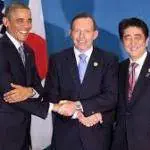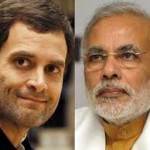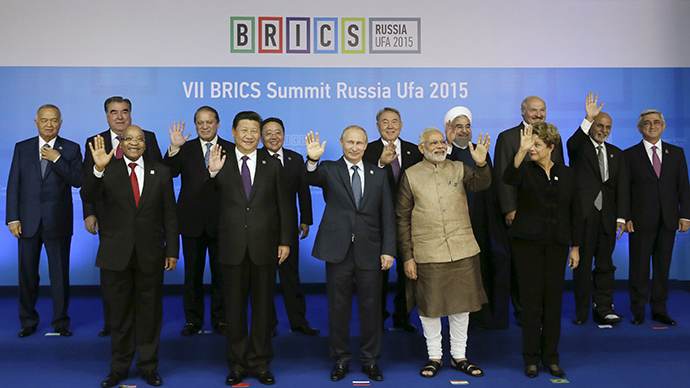“Modi! Modi! Modi!” chanted the crowd, which seemed to have learnt from watching the videos of his speech in New York. With hands going up like a slanted salute to take mobile phone snap shots, it appeared like they were hailing a hero. At the Allphones arena in Sydney and the unveiling of the Mahatma Gandhi statute in Brisbane, the crowds cheered in a way no leader has received in recent years. It clearly exemplifies an excellent event management strategy befitting a person of Modi’s stature.
Role of the diaspora
Prime Minister Modi’s visit to Australia and Fiji triggered some thoughts and inspiration to write about the change in perceptions about India under Modi’s statesmanship and stewardship.
His speeches are engaging and well thought of, making him definitely a dynamic personality exuding a charisma that appeals to all alike. The visits with rock-star receptions that he receives confirms a popular wave and boosts the image of the country and party, underplaying any thought of a mistaken fascist backed regime in India.
Moreover, it is the first time, (or the second, if you consider Mahatma Gandhi’s sojourn in South Africa) that the Indian diaspora has contributed to boost the image abroad, which currently has become essential to domestic and South Asian Regional politics. It is not the first visit by Modi to overseas destinations. He has been visiting the major centres of the diaspora around the world as a chief minister and even earlier as a Sangh Pracharak of the RSS (a functionary of the Rashtriya Swayamsevak Sangh ).
The diaspora has been carefully cultivated over several decades by the BJP (Bharatiya Janata Party). It must be acknowledged that while the diaspora has people from all the regions of India, some are in larger numbers and have a critical mass and culture to make the diaspora a cohesive one. These are the ones that have had their recent roots in India and likely holders of the Overseas Citizen of India (OCI) card. There is an extended diaspora of People of Indian origin (PIO), such as the descendants of people from India who were brought to the West Indies or Fiji in the 1800’s.
Modi’s bringing together of the OCI and PIO categories is a positive initiative, if one considers that there was a sense of insecurity for the PIO caused by a risk of being forced out of their countries for being ‘officially’ accepted by the India government system. (Indians have been ousted and in some cases prevented from forming governments despite electoral victories). India’s overseas image is of importance under these circumstances.
In this context, Modi and the BJP have achieved their goals.
The unprecedented welcome ceremonies have been possible mostly through Gujarat, whose people form the widest and largest influential part of the diaspora; through a Hindu ideology which has a majority; and a charismatic leader that belongs to and understands the former two aspects with a can do approach. It will be fair to say that it is a winning combination, which personalities within BJP or any other party, may not have easily achieved. It does confirm the active part the diaspora has played in Modi’s success in the international arena.
Regional security and economic partnerships
 While Modi was visibly not part of a handshake with the US-Japan-Australia security nexus, his speech in the Australian parliament and later in the Fijian one carries the messages of economic and security assertion. (India along with several other countries seeks membership in the APEC. Currently it is supported only by the US and Japan). The quadrilateral treaty proposed between US-Japan-Australia (-India), which is opposed by China has a remote significance on how India can handle any assertive or aggressive behaviours from Pakistan and China and an accompanying indifference from Sri Lanka.
While Modi was visibly not part of a handshake with the US-Japan-Australia security nexus, his speech in the Australian parliament and later in the Fijian one carries the messages of economic and security assertion. (India along with several other countries seeks membership in the APEC. Currently it is supported only by the US and Japan). The quadrilateral treaty proposed between US-Japan-Australia (-India), which is opposed by China has a remote significance on how India can handle any assertive or aggressive behaviours from Pakistan and China and an accompanying indifference from Sri Lanka.
These aspects have a bearing on strengthening of the Indian identity and nationalism, which seems to have arisen from the Kargil war days, and India’s security needs after the Mumbai terrorist attacks.
Modi’s extended visit on the wings of the G20 to Australia, one by an Indian PM after 28 years, points to India’s role in the region’s security. Australia itself has had differing approaches with each changing prime minister to a US led pact in the region at the cost of relations with China. It must be highlighted that China is Australia’s major economic partner, while not being one in a regional security arrangement. The opposite is with India, thus making any economic partnership with Australia an uphill climb. It will be interesting to see how this will pan out. A trade delegation from New South Wales will soon be on its way to Gujarat in the beginning of 2015. While the Uranium exports to India is in current favour, it seems to trigger a hasty aspiration by Pakistan to have 200 nuclear warheads in the near future.
India is at the coalface, with Nuclear tipped missiles deployed in Tibet. Recent news of a Chinese dam across the Brahmaputra seems to be an insinuation choreographed with the Pakistani nuclear aspirations. China never fails to send a message that the media in India is quick to report! The question is should India be bothered by these insinuations or have a clear cut agenda and be assertive?
Modi’s reference to “Make in India” both at the Allphones Arena and the Parliament is an important one. It proposes to capitalise on India’s strengths in Human Resources development like China did with its manufacturing abilities to produce goods that are at a very low cost to the retailer. If China could understand the specific demands of countries for goods (like made in China idols of Hindu Gods), India could well do the same for HR requirements, as Modi suggests. A wide diaspora, unlike a big one like China, can facilitate this growth. Australia has a huge shortage of a skilled workforce which it advertises frequently. However, their immigration policies can create barriers to entry.
Indian diplomacy or soft power has been built largely through overseas communities, unlike China whose diplomatic influences are led by the state. China has a concerted effort in building up institutions like the Confucius Institute and actively seeking partnerships between state run institutions and foreign universities and cities. India has an overseas population that has a clear and clean identity, unfettered by triads and negative influences. They could well develop its export of services, in a formal way.
China is a manufacturing hub, favouring the monopolistic mega supermarkets in countries professing democracy and an open market! Indian goods, perhaps not services, have a competition in China replacing it as a vendor and needs to device a mechanism to change the paradigm through trade agreements. According to the Australian Department of Foreign Affairs and Trade: China is India’s largest trading partner, with bilateral merchandise trade totalling US$66 billion in 2013. China was India’s largest source of merchandise imports and third-largest destination for merchandise exports (in 2013). ( http://www.dfat.gov.au/geo/india/india_brief.html). For Modi, the challenge is a domestic one.
India’s manufacturing can benefit through effective labour laws and depoliticising unionism, increasing infrastructure and moving away for unsuccessful models of the small scale industries. This is a complex issue and points to the low productivity of Indian labour. (The same is efficient and productive overseas, ironically for the same reasons such as laws, infrastructure and management). Modi can make a difference here through his can-do (or kick-ass) attitude. An authoritative approach under the umbrella of democracy will serve well.
Historical commonalities recognised
It was encouraging to listen to Modi’s reference to the Anglo Indian community’s contribution to Australia,
The role of Indian troops in Gallipoli, was an important point of reference in Modi as well as Abbot’s speeches.
“The Indian-Anzac inclusion in Australian thought ironically came much after the inclusion of Turkish ones.” Says Bawa Singh Jagdev OAM, JP, Secretary National Sikh Council of Australia Inc. Jagdev speaking at a forum in University of Technology Sydney, was referring to the participation of the community on Anzac Day Parades which now happens year on year. It took a long time for the community to get councils to agree to an Indian participation which happened years after a Turkish one!
This was important to the communities overseas more than for domestic politics, where up until recent times, the event held little significance even in India.
Back home into the South Asian ccauldron
While India’s image has received a morale boost in the South Pacific Region, closer home Sri Lanka and Pakistan warm up to China’s PLA Navy. This was bound to happen for some reasons. India’s peace keeping efforts in Sri Lanka during the Tamil Tiger insurgencies became a military intervention. From having initially supported the insurgency they became later adversaries. The insurgency was finally squashed, I suspect with covert help from Pakistan to the Sri Lankan forces. Further, India’s past objections to US presence in the Indian Ocean and facilities in Sri Lanka has perhaps pushed them into a Chinese corner.
A price India has to pay for being a weak regional hegemon.
Modi is the best bet to correct the situation and must need capitalise on his electoral victories and domestic leadership. These have made a great impact on the peoples of the SAARC nations, who are awed by India’s democracy and Modi’s charismatic ways. This needs to be translated to a regional leadership. Modi has handled the cross border violations in a befitting manner, the next event is the elections in Kashmir, which could well be a game changer.
The elections in Kashmir commence the 25th of the month. This is an important event running concurrently to the SAARC meeting commencing on the 26th. Nepal has taken on the role to facilitate and broker meetings between Nawaz Sharif and Modi. It is an interesting role for Nepal to play, considering they have warmer relations with China in recent years. China does seek a seat at SAARC, and it seems to have all the smaller nations in its pocket. While India is seeking a greater role at a higher table, it is losing sight of its smaller neighbours.
An assertive policy towards China was played out during the BJP’s last rule and Pokhran II did serve a purpose. Further, India’s bilateral friendships in Southeast Asia and the Pacific seems to provoke, and not counter China’s aspirations in the South Asian region. Towards this, India needs to insist on a place in the Shanghai Cooperation and Six Party Talks, only if to counter China’s relevancy in the SAARC. Pakistan actively proposes China and blocks India’s entry into international forums
While the diplomatic paradigms in the region may not change easily, Modi does need to progress his domestic promises, as they will have a positive bearing on India’s regional imbalances relying on the impressions and influences created across borders with common issues. A concerted diplomatic pressure on China, unfortunately seems to be the only way, till the mythical blue water navy becomes a reality.
Modi’s initiative to give states greater overseas interaction is a step forward. There is a majority number of states that border with neighbouring countries. It may do well for them to have cordial and beneficial relations with the SAARC countries at a state level, not entirely at the risk of decentralising foreign relations. Promoting open borders, comfortable rules of trade, people to people interaction and other CBMs at a state level. This may well strengthen central authority rather than weaken it.
Encirclement, balance of power, unequal treaties all seem to be mechanisms of the past. In a progressive world rapprochement and economic prosperity must take precedence. China has a clear agenda to be militarily mightier than the US, which has invested in the Pacific region and will not give up its position easily.
India is moving from being important to relevant, Modi has started the ball rolling!





